Clinical Disease
Hansen’s disease is a chronic infectious disease caused by Mycobacterium leprae and usually affects the skin and peripheral nerves, but can have a wide range of possible clinical manifestations.
Patients can be classified into three groups, each with slightly different signs and symptoms:
-
Paucibacillary (PB), or tuberculoid, Hansen’s disease is characterized by one or a few hypopigmented or hyperpigmented skin macules that exhibit loss of sensation (anesthesia) due to infection of the peripheral nerves supplying the region. The body’s immune response may also result in swelling of the peripheral nerves; these enlarged nerves may be palpated under the skin, and may or may not be tender to the touch. The nerves most often found to have swelling are:
- Great auricular nerve
- Ulnar nerve above the elbow and dorsal cutaneous branches at the wrist
- Median nerve at the wrist (in the carpal tunnel)
- Radial nerve (superficial at wrist)
- Common peroneal nerve (also femoral cutaneous and lateral popliteal nerves where they wind around the neck of the fibula)
- Posterior tibial nerve, posterior to the medial malleolus
- Sural nerve
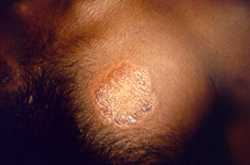
A large lesion on the man’s left chest is shown here, attributed to paucibacillary (PB) Hansen’s disease
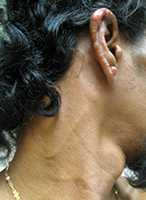
Visible enlargement of the great auricular nerve due to infection with M. leprae.
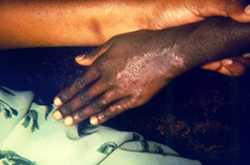
This patient presented to a clinical setting with an active cutaneous lesion on the left hand, which was determined to be due to paucibacillary Hansen’s disease.
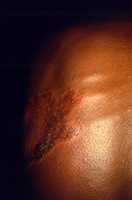
This patient presented to a clinical setting with an inflammatory cutaneous lesion on the thorax, which was determined to be the paucibacillary form of Hansen’s disease. Note the enlarged costal nerves below the skin that were affected by the disease and which were supplying the leprous lesion.
-
Multibacillary (MB), or lepromatous, Hansen’s disease is characterized by generalized or diffuse involvement of the skin, a thickening of the peripheral nerves under microscopic examination, and has the potential to involve other organs, the eyes, nose, testes, and bone. The nodular form of this condition is the most advanced form of the disease. Ulcerated nodules contain large numbers of M. leprae acid-fast bacilli packed in macrophages that appear as large foamy cells. MB form of Hansen’s disease is associated with:
- multiple, symmetrically-distributed skin lesions that might not exhibit loss of sensation
- nodules
- plaques
- thickened dermis
- frequent involvement of the nasal mucosa resulting in nasal congestion and epistaxis

The face of this male patient exhibited some of the pathologic characteristic associated with a case of nodular lepromatous, or multibacillary (MB), Hansen’s disease. Of note is the presence of cutaneous nodules upon the forehead, nose, cheeks, lips, and chin. The eyebrows are diminished as well.
- Borderline, or dimorphous, Hansen’s disease is the most common form. When compared to tuberculoid or lepromatous forms, it is of intermediate severity. The skin lesions seem to be of the tuberculoid type, but are more numerous, and may be found anywhere on the body. Peripheral nerves are affected as well, with ensuing weakness and anesthesia.
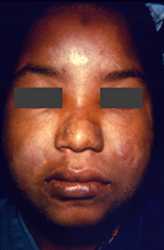
This young woman presented with a case of borderline Hansen’s disease with bilateral involvement of the patient’s buccinator, or cheek muscles, as well as dermatomyositis evidenced by the cutaneous rash-like discoloration overlying the muscles beneath.
- Page last reviewed: January 31, 2017
- Page last updated: January 31, 2017
- Content source:


 ShareCompartir
ShareCompartir